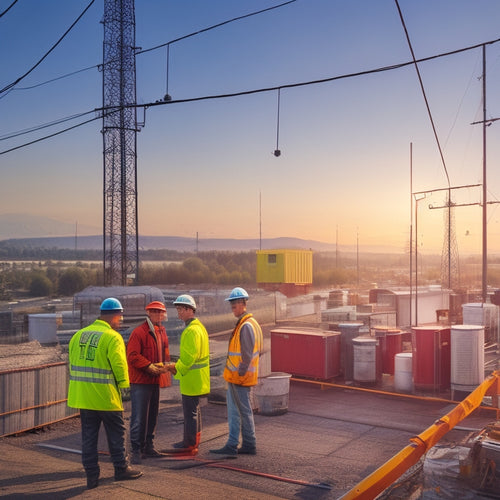
Prepare for the Unexpected With These Emergency Kit Essentials
Share
To prepare for the unexpected, equip yourself with essential emergency kit items. Start with a thorough first aid kit, including bandages, antiseptic wipes, and pain relievers. Stock at least three days' worth of non-perishable food and water, aiming for one gallon per person daily. Don't forget a manual can opener and a reliable flashlight with extra batteries. Tailor your kit to your family's size and specific needs, including pet supplies if applicable. Regularly check and update your supplies to guarantee readiness. Learn how to enhance your preparedness further and investigate more essential items.
At a Glance
- Assemble a comprehensive first aid kit containing essential supplies like bandages, antiseptic wipes, and pain relievers for effective injury management.
- Stock non-perishable food items and at least one gallon of water per person each day to sustain your family during emergencies.
- Include emergency gear such as flashlights, multi-tools, and a battery-powered radio to stay informed and safe.
- Develop a reliable communication plan with clear protocols, ensuring all family members understand their roles during a crisis.
- Tailor your emergency kit to your family size and unique needs, including supplies for pets and specific items for young children.
Expert-Recommended Emergency Supplies
When preparing your emergency kit, it's essential to include expert-recommended supplies.
Start with an all-inclusive first aid kit to handle injuries effectively.
Additionally, consider incorporating a battery backup system to guarantee your essential devices remain operational during power outages.
Don't forget to stock up on non-perishable food items to sustain you during emergencies.
First Aid Supplies
Stocking your emergency kit with essential first aid supplies is essential for handling injuries or medical issues that may arise during a crisis. You never know when you might need to apply first aid techniques, so being prepared is imperative.
Start with adhesive bandages in various sizes, sterile gauze pads, and medical tape to cover cuts and scrapes. Include antiseptic wipes or solutions to clean wounds and reduce the risk of infection.
Don't forget about a pair of scissors and tweezers, as these tools can be lifesavers when dealing with splinters or cutting through clothing. Pain relievers like acetaminophen or ibuprofen can help alleviate discomfort, while a thorough first aid manual offers guidance on emergency response.
It's wise to include gloves to protect yourself and the injured party during treatment. Also, consider adding a thermometer and a space blanket for additional care.
Non-Perishable Food Items
Having a supply of non-perishable food items is essential for any emergency kit. You need to verify you have enough food to sustain you and your family during unexpected situations. Canned goods are a great choice; they're easy to store and have a long shelf life. Beans, vegetables, and soups can provide necessary nutrition and variety.
Consider adding freeze-dried meals to your kit as well. These meals are lightweight and can be prepared with just hot water, making them convenient in emergencies. They also pack a punch regarding calories and nutrients, keeping your energy up when you need it most.
Don't forget to include a manual can opener if your canned goods aren't pop-top. It's a small detail that can make a big difference in a crisis.
Lastly, remember to rotate your supplies regularly to maintain freshness. Check expiration dates, and replace items as needed.
Enhanced Safety and Preparedness
To enhance your safety and preparedness, start by creating an essential supplies checklist customized to your needs.
This list should include items that can support you in various emergencies, such as a portable solar generator to guarantee reliable power supply during outages.
Additionally, establish an emergency communication plan to make sure you and your loved ones can stay connected during a crisis.
Essential Supplies Checklist
An effective emergency kit can make all the difference when disaster strikes. To guarantee you're prepared, start by gathering essential supplies that cover all bases. First, include emergency gear like a flashlight, extra batteries, and a multi-tool. These items may prove crucial in unexpected situations.
Next, don't forget about first aid supplies. Pack adhesive bandages, antiseptic wipes, and any necessary prescription medications. Also, add non-perishable food and water—aim for at least a three-day supply per person.
Kit organization is key. Use airtight containers or bags to keep everything dry and accessible. Label each section for quick reference; this way, you won't waste precious time searching for items under stress.
Consider personal needs too. If you have pets, pack food and supplies for them. Include a battery-powered or hand-crank radio to stay updated on emergency information.
Emergency Communication Plan
Creating an emergency communication plan is essential for ensuring you and your loved ones can stay connected during a crisis. A solid plan helps you steer through uncertainty with confidence. Here's how to set it up effectively.
First, identify reliable communication tools. Consider options like text messaging, social media, or dedicated apps that can function even when standard services are down. Next, establish clear message protocols. Decide on key phrases or codes that everyone understands to convey the situation quickly.
Use the table below to outline your plan:
| Contact Name | Contact Method | Message Protocol |
|---|---|---|
| Family Member 1 | Text/Social Media | "I'm safe" / "Need help" |
| Family Member 2 | Phone Call | "Check-in" / "All good" |
| Friend 1 | App (e.g., WhatsApp) | "Location update" |
| Friend 2 | Text | "Stay put" |
| Emergency Contact | "Emergency status" |
Regularly review and practice your plan. That way, you'll know how to respond, keeping your freedom intact during any emergency.
Key Items for Survival Kits
When assembling your survival kit, make certain to include water and food supplies to keep you nourished and hydrated.
It's also important to take into account power sources, such as battery backups, to guarantee your devices remain functional during emergencies; monitoring your battery state of charge can be vital in maintaining these power sources.
First aid essentials are also vital, as they can help address injuries or health issues that may arise in an emergency.
Being prepared with these key items can make all the difference in a crisis.
Water and Food Supplies
Water and food supplies are critical components of any emergency kit, guaranteeing you can sustain yourself during unforeseen circumstances. You never know when you might be cut off from basic resources, so it is crucial to prepare ahead of time.
Key Items for Water and Food Supplies
| Item | Purpose | Notes |
|---|---|---|
| Water Purification Tablets | Guarantee safe drinking water | Carry enough for your needs |
| Non-perishable Food Bars | Quick energy source | High in calories, lightweight |
| Canned Goods | Versatile meal options | Choose items with a long shelf life |
When it comes to water, aim for at least one gallon per person per day. Don't forget to include water purification methods in your kit, like tablets or filters, to guarantee you can access clean water if needed. For food, consider emergency rationing; pack nutrient-dense, non-perishable items that require minimal preparation. By prioritizing these supplies, you equip yourself to maneuver through any unexpected situation with confidence and independence.
First Aid Essentials
After securing your water and food supplies, it's time to focus on your first aid kit. This essential element of your emergency preparedness should include a variety of items aimed at wound care and injury prevention.
Start with adhesive bandages in various sizes for minor cuts and scrapes. Don't forget antiseptic wipes or solution to clean wounds and prevent infection.
Include sterile gauze pads and adhesive tape for larger injuries. An instant cold pack can help manage swelling or pain from sprains. You should also have a pair of medical gloves to maintain cleanliness and prevent contamination while treating wounds.
Consider adding a basic first aid manual to guide you through common injuries and their treatments. Pain relievers like ibuprofen or acetaminophen will help in managing discomfort.
Lastly, remember to check your kit regularly and replace expired items. By being proactive with your first aid essentials, you're not just preparing for the unexpected—you're taking control of your safety and well-being.
With the right supplies, you can handle injuries effectively and confidently, ensuring your freedom during emergencies.
Selecting Based on Family Size
When selecting an emergency kit, consider your family's size to guarantee everyone has what they need. A small kit might suffice for one or two people, but larger families will require more supplies and variety.
Tailoring your kit guarantees that essential items are available for everyone, from food and water to medical supplies.
Additionally, incorporating a solar battery backup system can provide reliable energy during emergencies, guaranteeing that critical equipment remains operational and enhancing overall preparedness for unexpected situations.
This approach aligns with energy independence and reliability, further supporting your family's needs during crises.
Tailoring Kits for Size
Creating an effective emergency kit starts with understanding your family's unique needs. Kit customization is vital, as what works for one family may not suit another.
If you have young children, you'll want to include items like extra diapers, formula, or comfort toys. For families with teenagers, think about including personal hygiene products and their preferred snacks.
Consider the number of members in your household. A family of four will require more food, water, and first-aid supplies than a couple.
Think about how long you might need to be self-sufficient. A three-day supply of essentials is a common guideline, but adjust this based on your family size and specific needs.
Don't forget about pets! If you have furry friends, include pet food, leashes, and any medications they might need.
Lastly, regularly review and update your kit. Family needs change, and it's important to keep your supplies relevant and ready.
Essential Supplies for Everyone
In an emergency, having the right supplies can make all the difference, so it's essential to select items based on your family size. When it comes to family preparedness, one size doesn't fit all. Consider how many people you need to prepare for and tailor your emergency kit accordingly.
For a family of four, stock up on enough food and water to last at least three days. Aim for one gallon of water per person per day, along with non-perishable food items like canned goods, granola bars, and dried fruits. Don't forget to add a manual can opener!
If you have young children, include items like diapers, formula, and baby food. For families with pets, pack extra food and water for them too.
Emergency planning should also involve medical supplies—keep a first aid kit that caters to everyone's needs. Include prescription medications, allergy medications, and any specific items required by family members.
Proven Effectiveness in Crises
Throughout history, emergency kits have proven their worth in various crises, saving lives and providing essential support.
By examining successful responses to past emergencies, you can gain understanding into what items really make a difference.
Understanding these historical success stories helps you build a more effective emergency kit for your family.
Historical Success Stories
When emergencies strike, having an effective kit can make all the difference, as countless historical success stories illustrate. From the aftermath of Hurricane Katrina to the 9/11 attacks, individuals and communities equipped with essential supplies have managed to maneuver dire circumstances.
Take the case of the 2004 Indian Ocean tsunami. Survivors who'd emergency kits on hand, containing food, water, and first aid supplies, found themselves better prepared to face the chaos. Their survival stories highlight the importance of planning and readiness.
Similarly, during the California wildfires, residents who evacuated with emergency kits reported greater ease and less anxiety.
These historical disasters show that having the right tools can't only save lives but also provide a sense of control in uncertain times.
Frequently Asked Questions
How Often Should I Check and Update My Emergency Kit?
You should check and update your emergency kit at least twice a year. Regular maintenance guarantees your supplies remain effective, and adjusting for changing needs keeps your emergency kit ready for any situation you might face.
Can I Use Regular Household Items in an Emergency Kit?
You can absolutely welcome household substitutions in your emergency kit. Think creatively—old towels can serve as bandages, and a flashlight can double as a guiding light. Your everyday items can be lifesavers when it matters most.
What Should I Include for Pets in an Emergency Kit?
When packing your emergency kit for pets, include pet food and a first aid kit specifically designed for animals. Don't forget their favorite toys and any necessary medications to guarantee their comfort and safety.
How Can I Store My Emergency Kit Safely?
Your emergency kit's like a superhero, ready to save the day! For effective emergency kit organization, use waterproof bins and label everything. Store them in a cool, dry place for best storage solutions and easy access.
Are There Any Specific Items for Natural Disasters in My Area?
You should identify local hazards like floods, earthquakes, or hurricanes. Then, focus on disaster preparedness by including items such as a flashlight, water, first aid kit, and non-perishable food customized to your area's risks.
Explore More
In the unpredictable storm of life, being prepared is your anchor. With the right emergency kit essentials, you're not just collecting supplies; you're weaving a safety net for yourself and your loved ones. Remember, whether it's a family of two or ten, selecting appropriate items can make all the difference. Don't wait for the clouds to gather—gear up now, and you'll face any crisis with confidence and resilience, ready to weather whatever comes your way.
Related Posts
-

The Role of Battery Monitoring Systems in Renewable Energy
Battery monitoring systems play an essential role in renewable energy by enhancing system longevity and optimizing pe...
-

Essential Hiking Lights for Safety and Fun
When you're hitting the trails, essential hiking lights are vital for safety and fun. A lightweight headlamp offers h...
-

Smart Grid Technology Implementation Challenges
You'll encounter several challenges when implementing smart grid technology, particularly in cost management, scalabi...


